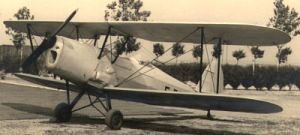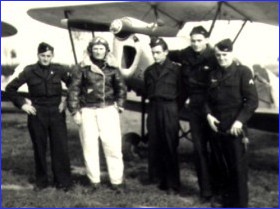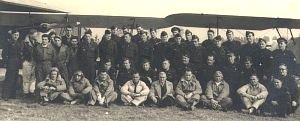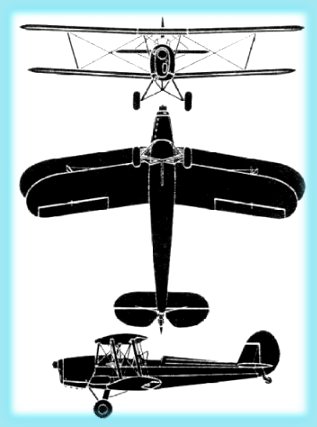 800/360
- 59 ko
800/360
- 59 ko
The STAMPE-SV 4C
Click to enlarge: 800/360
- 59 ko
800/360
- 59 ko
Stampe on the Mitry-Mory airfield in 1952
Here is the airplane that has given me so much pleasure during my short career
as a pilot, although I only flew it a few hours!
For me, as for practically all the military pilots of my generation, it was the very first airplane that I flew.
It was also the first airplane that I soloed, the first step towards being " knighted " as a French Air
Force pilot. After the first solo, the fledging aviator received his student pilot insignia, similar to the one
bestowed upon graduation as a pilot, but with only one wing…Another formality, was to sign a 5 years contract with
the French Air Force!!!
In 1952, the French Air Force was recruiting pilots intensively! Luckily for me, the recruiting requirements were
somewhat relaxed during this period of high demand, and thus, I was admitted with only the certificate of primary
education (CEP) in my pocket! In fact, the recruiting was so heavy that it was necessary to patiently wait many
months before being sent to advance training in Marrakech Morocco, or elsewhere (Canada or USA).
In a few words, the primary training on the Stampe known as " Initiation and selection " was conducted
in French Aero-Clubs or National Centers such as; Saint-Yan, Challes les Eaux, Le Bourget du Lac, and in my case
at Mitry-Mory near Paris. There, operating side by side was a mixture of French Air Force, and mostly civilian
personnel consisting of: a chief pilot, flight instructors (most of them ex WW2 military pilots), and mechanics.
We were about thirty student pilot candidates, out of which I was the oldest with my 25 years of age and already
holding the rank of Chief Sargent! !
Along with the flying, we had ground school on the pertinent subjects of theory of flight, aerodynamics and mechanics
of flight, navigation, meteorology, and regulations. I presume that the civilian pilot candidates had to acquire
the same basic knowledge, and for most in my group it was mostly a review, but for me, having no prior exposure
to these technical subjects, I had to do a lot of diligent studying. I have found after many years, the notebooks
that I use to keep meticulously! Later on, in the advanced flight schools of Marrakech Morocco, and Avord France,
I continued to review and keep up my notes, and it certainly helped me to achieve the final goal: the coveted pilot's
wings.The results of the theoretical tests were as important as flying progress.
 My instructor, Mr Corbin and his 4 students |
|
Enlarge 600/747 53 ko . |
Enlarge 650/485 57 ko |
This is therefore the atmosphere under which, (after a very long wait) that I completed
the first phase of pilot training on the Stampe SV-4C; my real initiation to flying on this still very beautiful
airplane. Before that, my aeronautical experience after 7 years of military service consisted only of flights as
a passenger.From my first flight on September 9th 1952, to October 11th 1952, I flew the Stampe for a total of
15 hours, including one-hour solo. I soloed after 10 hours of dual instruction.
The training included many landings (103), perhaps the most difficult phase of training.
As for all tailwheel airplanes, it was necessary to touchdown in the three point's attitude, especially with the
Stampe, if not, the airplane would bounce repeatedly. For takeoff, one had to be careful to be firm but gentle
on the controls, avoiding rough usage of the stick and rudder. I keep excellent souvenirs of " my " first
airplane. It was agile, responsive, and gave the student a special feel for transitioning on other airplanes.
As for the impressions of the first solo, it was special, very special.
On the Stampe, the center of gravity location requires that solo flights must be made from the rear seat, and therefore,
the instructor sits in the front cockpit. For the 10 hours or so of dual instruction, you see his head in front
of you, then when he finally tells you " she is all yours ", that front cockpit now looks mighty empty!
There is a strange feeling in the stomach, and your legs are somewhat shaky. But, as soon as the wheels leave the
ground, euphoria takes over, it is heaven on earth… until the final approach that is. Then, it is time to land,
and the feelings experienced on takeoff return .Despite a bounce or two, the flight ends well, you have made it!.
After this first solo, a few allocated hours remained, which were used for " polishing " and giving confidence
to the students. Those extra hours were too few, but we were told that we were now ready and able to continue our
training on the T-6. We were still a long way from " Knighthood ", lots of training remained on the T-6
and hence on multi-engines before receiving the French Air Force pilot's insignia with both wings this time, the
coveted " Macaron ".
I never had again the opportunity to fly the Stampe, and I regret it very much. Aerobatics training would have
been more pleasant on the Stampe than on the T-6! !
Click to enlarge.. 800/320- 69ko
800/320- 69ko
Student pilots graduation in Mitry In October of 1952.
(I am the second on the right standing. My instructor is the second on the left with the " bomber jacket ")
At the Aero Club near where I live, it is still possible to admire the Stampe's beautiful lines (as well as the T-6, Flamant, and Broussard, which I have also flown). It is always emotionally that I see those " friends " again after more than 40 years. Unfortunately, I do not have the chance to even sit in them, and even less, the chance to fly them.
| Technical characteristics of the Stampe : Biplane of Belgium origin, the Stampe and Vertongen (SV-4) first flew in 1933 as a training airplane. After WW2, its construction was taken over by France by the " Sociétée Nationale de Construction Aéronautique du Nord (SNCAN) under the designation SV-4C. This version was equipped with a 140 HP Renault engine 4 Pei. Wingspan = 9.7 meters Length = 7.1 meters Height = 2.7 meters Empty weight = 470 kilos Total weight = 760 kilos Maximum speed = 180 km/h Landing speed = 70 km/h Ceiling = 6,000 meters Number of airplane built = 700 The Stampe was adopted as a training airplane by the French Aero Clubs and by the famed " Patrouille d'Etampes ". It is one of the rare airplanes never "junked" but always bought and restored by collectors, and even by some clubs, giving the Stampe fans the pleasure to look at this beautiful airplane once more at some sport flying airfields. |
 |